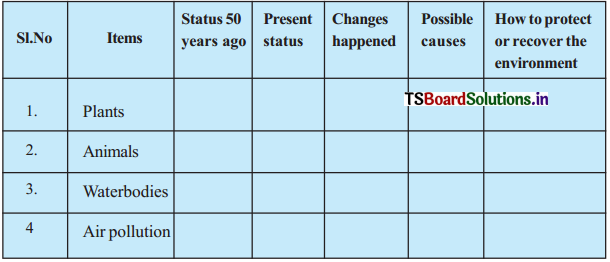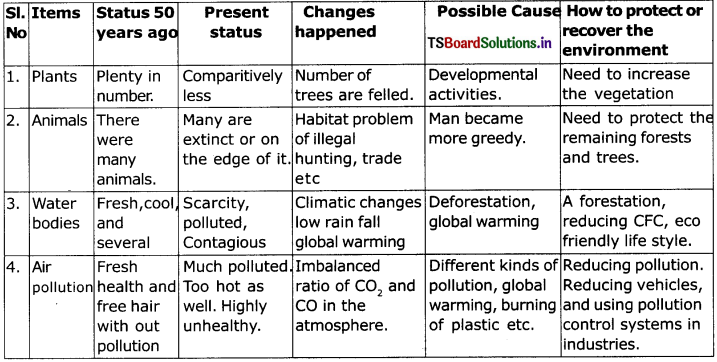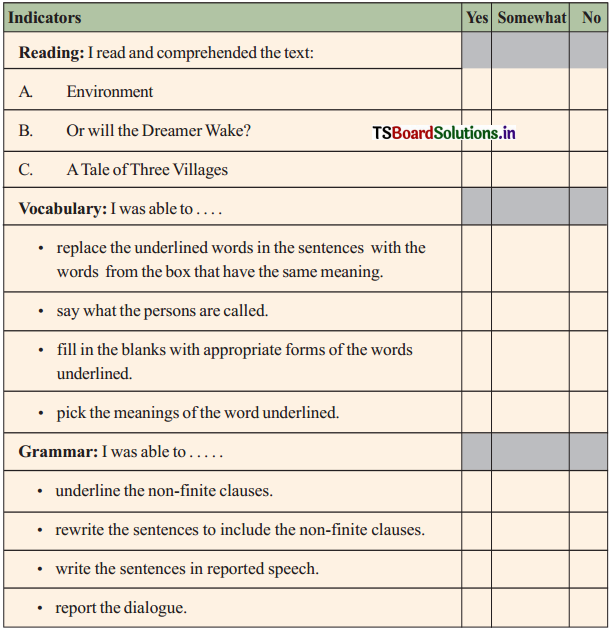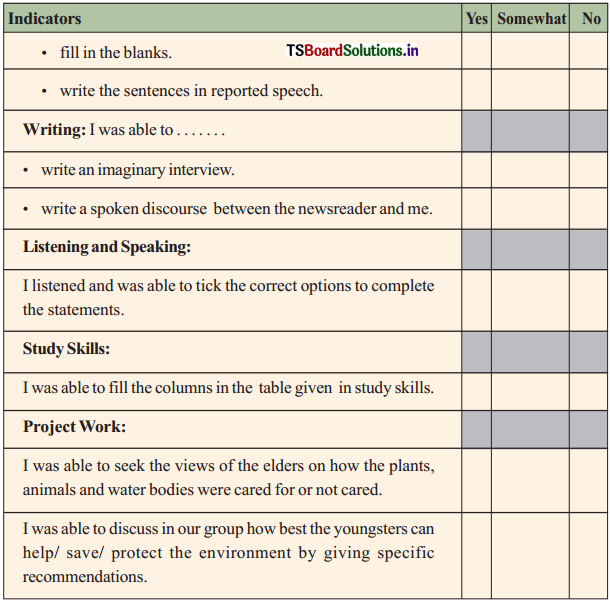Telangana SCERT TS 10th Class English Guide Pdf Unit 6C A Tale of Three Villages Textbook Questions and Answers.
TS 10th Class English Guide Unit 6C A Tale of Three Villages
Comprehension:
I. Answer the following questions briefly.
Koko Village, Nigeria
Question 1.
Why were the large empty drums placed outside Mr. Nana’s house?
Answer:
Some chemical factories of Italy unloaded metal drums of poisonous chemical near a stream that the villagers get their drinking water from. There were such large empty metal drums outside Mr. Nana’s house. These drums might have failen down and rolled or been rolled by playful children.
Question 2.
What harm can the pyramid of identical drums cause to the villagers?
Answer:
The slimy contents of various colours are leaking out from the drums and flowing down on to the African earth and into the stream which is a source of drinking water to the villagers. They may cause health hazards.
Question 3.
Why was the Chief smiling as the lorries drove away?
Answer:
The chief was given a brown bag by those who came there. Probably it would have been the bribe for him, to allow them to place the drums there. The cheif might have colluded with an Italian businessman to allow him to dispose the toxic wastage drums there.
![]()
Question 4.
Was Thomas Agonyo correct in his findings? Justify your opinion.
Answer:
Yes, Thomas Agonyo was correct in his findings. The drums were filled with poisonous chemicals, which had caused the death of many people in the village.
Question 5.
Why didn’t the people move from their place?
Answer:
The people in the village didn’t move from the place because they have no other choice.
Question 6.
There is a repetition of sentences with ‘some’ in the passage. Read the passage again and write down the sentences and the function of ‘some’ in each one of them. Do you find any other repetitions in the passage? If yes, mention it.
Answer:
Some of them are badly corroded, their slimy contents of various colours – grey, dark green, bright orange, etc. – leaking out, down, bn to the baked African earth and into the stream. Some have fallen down and rolled – or been rolled by playful children – into the bush. Some are smoking In the midday heat. Some are swelling, as if their contents are bursting to get out. Some have already burst.
In the above passage, the word ‘some’ is used to describe the positions of the metal drums in the village.
Other repetitions:
- “They came on a Wednesday”, said Sunday, “Many, many big lorries “
- They took all day unloading them.
- They gave the Chief a brown paper bag -I saw him smiling as the lorries drove away.
Other such repetitions:
- We have asked the government to take the drums away, but they do nothing….
- We have written to Italy, but they do nothing.
- We have no money to buy land.
- We have no choice.
- We have to stay here.
![]()
II. Choose the correct answer:
Question 1.
Nana’s house is _________
a) picturesque, colourful and noisy.
b) with mud walls and a rusting corrugated iron roof.
Answer:
b) with mud walls and a rusting corrugated iron roof.
Question 2.
_________ is visible on the empty metal drums.
a) bright red paint flaking away
b) skull and crossbones symbol
Answer:
b) skull and crossbones symbol
Question 3.
The important conclusion Thomas Agonyo gave is that _________.
a) the drums had come from Italy.
b) the drums contained poisonous chemicals
Answer:
b) the drums contained poisonous chemicals
![]()
III. Write the adjectives or adjective phrases that describe the happy and gloomy situations in the village.
Ponnimanthuri Village, India:
Question 1.
The people in this village were affected by chemical factories. Where, in your opinion, should the factories be built? Why ?
Answer:
The location of factories that are dealing wjth dangerous chemicals need to be located in the outskirts. Outskirts being not much populated areas, people won’t be much affected by the effect of the chemicals, and the companies also will find enough space to build the treatment plants, so that the.pollution could be well controlled.
Question 2.
If it is necessary to build factories near the villages, what precautions should be taken to keep the villagers safe?
Answer:
It should be made clear that the unit does not affect the normal life of the people, in anyway.
The farms and the land area in the region should not be damaged.
Proper waste recycling / management system should be established and maintained properly.
Proper health and medical facilities, along with that of pure drinking water, should be provided. Special ask ponds must be there for the discharged chemicals.
Question 3.
The narrator said at the end, “There is so much they didn’t tell you, I thought”- what was that so much that was not told, according to you?
Answer:
Vijayasama sighed and reported to the narrator that the leather industry management didn’t tell them that the chemicals would be dumped in open fields and into their rivers. They didn’t tell them that their women would have to walk ten kilometers for drinking water every day and they would get ulcer and sores on their bodies.
But the narrator thinks that they don’t know some more hidden hazards till now. They don’t know there won’t be any life in Ponnimanthuri village on one day. They will either be died or been forcibly evacuated. By keeping this view the narrator said like that at the end.
![]()
Vorobyov Village, Ukarine (formerly USSR)
Question 1.
What measures should the government have taken when the nuclear reactor was installed beside the village?
Answer:
The government should make it sure that the safety measures regarding the plant is fool proof.
Question 2.
_________ is visible on the empty metal drums.
a) bright red paint flaking away
b) skull and crossbones symbol
Answer:
b) skull and crossbones symbol
Question 3.
The important conclusion Thomas Agonyo gave is that _________.
a) the drums had come from Italy.
b) the drums contained poisonous chemicals
Answer:
b) the drums contained poisonous chemicals
![]()
III. Write the adjectives or adjective phrases that describe the happy and gloomy situations in the village.
Answer:
| HAPPY | GLOOMY |
| Picturesque, Colourful, stream, playful, smiling, brightest | Skull and cross bone symbols, corroded, leaking out,fallen down, smoking,swelling, bursting, poisonous, frowning,troubled, death, sick, troubled, pain… |
Ponnimanthuri Village, India:
Question 1.
The people in this village were affected by chemical factories. Where, in your opinion, should the factories be built? Why ?
Answer:
The location of factories that are dealing wjth dangerous chemicals need to be located in the outskirts. Outskirts being not much populated areas, people won’t be much affected by the effect of the chemicals, and the companies also will find enough space to build the treatment plants, so that the pollution could be well controlled.
Question 2.
If it is necessary to build factories near the villages, what precautions should be taken to keep the villagers safe?
Answer:
It should be made clear that the unit does not affect the normal life of the people, in anyway.
The farms and the land area in the region should not be damaged.
Proper waste recycling / management system should be established and maintained properly.
Proper health and medical facilities, along with that of pure drinking water, should be provided. Special ask ponds must be there for the discharged chemicals.
Question 3.
The narrator said at the end, “There is so much they didn’t tell you, I thought”- what was that so much that was not told, according to you?
Answer:
Vijayasama sighed and reported to the narrator that the leather industry management didn’t tell them that the chemicals would be dumped in open fields and into their rivers. They didn’t tell them that their women would have to walk ten kilometers for drinking water every day and they would get ulcer and sores on their bodies.
But the narrator thinks that they don’t know some more hidden hazards till now. They don’t know there won’t be any life in Ponnimanthuri village on one day. They will either be died or been forcibly evacuated. By keeping this view the narrator said like that at the end.
![]()
Vorobyov Village, Ukarine (formerly USSR):
Question 1.
What measures should the government have taken when the nuclear reactor was installed beside the village?
Answer:
The government should make it sure that the safety measures regarding the plant is fool proof.
They need to keep a safety line area kind of thing so that the people won’t get settle very close to the reactor.
The people in the villages nearby should be made aware of the different warnings and enough training and drilling should be given for them.
Rehabilitation, medical assistance etc should be arranged in a reachable area, in case of emergencies.
Question 2.
What havoc can radioactive dust cause?
Answer:
Radioactive dust causes vomits and hair fall. People grow thin and sores appear all over the body. Within days deaths occur on a large scale. The fields will become barren. There will be no birds or animals. The affected towns or villages will never be suitable places to live. The people who never die will have to move to other places.
Question 3.
Pick out the words/expressions/images that describe the tragedy caused by the radioactive dust.
Answer:
A week later the children began to vomit. Their hair fell out. They couldn’t eat. They grew so thin, and sores appeared all over their little bodies. Two weeks after that, all three died – all three on the same day.” She broke down now and cried quietly, as she had done so many times before.
It was a ghost town. No one lived there anymore. They had either died or forcibly evacuated. The fields were barren. Nothing grew. Nothing ever would again. There was no bird song. No rabbit peered at me. No cow endlessly chewed. No horse neighed.
Question 4.
What is the common theme that runs through the assorted narratives presented under the title ‘A Tale of Three Villages’? Substantiate your answer with evidences from the three Texts?
Answer:
The common theme that runs through the three texts provided are how a section of people bear the effects of pollution, which was not caused by them, but has to suffer. The industries/ Developed Regions etc often find someone unprivileged or under privileged to suffer for them.
The Koko Village in Nigeria is facing the problems caused by the dangerous chemicals in the barrels dumped by Italy.
Ponnimanthuri Village bears the wound of the environmental issues caused by the leather factories that got developed in the region.
Chernobyl, in Ukraine was an accident, which caused huge leakage of Atomic elements from the Nuclear Reactor.
![]()
Comprehension:
Koko Village, Nigeria:
Quantifiers as the name implies are a type of determiners which denote imprecise quantity. They differ from numbers or numerals which indicate precise quantity.
Example:
I’ve got some apples in my basket and some water in my bottle.
I haven’t got any apples in my basket, nor any water in my bottle.
Generally quantifiers are used before nouns.
Some, any, all, no, no one, both, each, every, several are some of the quantifiers. “Some” is usually thought of as the positive counterpart to “any” in many circumstances. “Any” can be used before countable and uncountable nouns usually in questions and negative sentences.
Example:
- Are you bringing any friends with you?
- I am bringing some friends with me.
Quantifiers come before nouns. Some of the quantifiers you find in the text are:
some, any, no. You also find numerals. Pick out the nouns along with quantifiers and numerals and write them down and analyze the meaning they convey.
Answer:
- Any other African village → like the other African villages
- Some of them → a few drums in the heap of drums.
- Some of them are badly corroded → a few drums got rusted
- Some have fallen down and rolled – or been rolled by playful children → a few drums are rolled down from the enormous pyramid of drums.
- Some are smoking in the midday heat → a few drums among the heap of drums are smoking due to chemical reaction.
- Some are swelling, as if their contents are bursting to get out → a few drums are bulged and ready to burst.
- Some have already burst → a few drums are already burst.
![]()
Fill in the blanks appropriately with the following quantifiers:
no, any, all, some, each, several and every.
Question 1.
_________ ordinary person is bothered about climatic changes. If we talk of _________ changes, people look at us as if we don’t have _________ work. In fact, it is such a grave problem that _________ person has to think about. _________ scientists feel alarmed because the ozone layer is depleting. In addition, _________ people believe that the global warming is creating climatic problems. But _________ single individual shows concern for it.
Answer:
No, any, any, each, every, All, several, no, any
Question 2.
_________ meteorologists predict that the world will get warm between 2 to 4 degrees Celsius by the year 2030. The scientists believe that _________ year _________ polar ice will melt and cause rainfall, increase in the sea level and also temperature will be affected. _________ people disagree with the theory that the human activity is having an effect on the world’s climate. _________ scientists need to monitor the Earth’s atmosphere and human being needs to care for the air, water and plant life that influence world’s weather.
Answer:
some, every, some Several, All, each and every.
3. People who disagree with the theory that there is a direct relationship between the human activity and climate believe that the world climate has gone through _________ changes since the earth and its atmosphere first formed. So for _________ argument there is a counter argument. _________ individual differs with the other in _________ way or the other.
Answer:
several, any, Every, some
![]()
Ponnimanthuri Village, India:
Write the following sentences in reported speech:
Question 1.
“I can remember the time.” she said wistfully, “when all the fields around this village were green and the harvests good.”
Answer:
She wistfully said that she could remember the time when all the fields around that village had been green and harvests good.
Question 2.
“They said that factories need leather to make shoes, handbags and clothes. They
said our men folk would get jobs. They said we would all become rich.”
Answer:
It was reported that they had said that the factories needed leather to make shoes, handbags and clothes, their menfolk would get jobs and they would all become rich.
Writing:
Out of the three villages you have read about, choose one village of your choice (you may also choose a completely different one). You are a T.V. reporter. You need to go to one of the villages and from there you have to report orally to the news channel what all you find there. How would you report?
Write the script – the dialogue between you and the T.V newsreader.
Answer:
The beginning is given below:
T.V. News Reporter : Our correspondent reports from Koko village – What is the situation there? How do you find the village? What are the people around saying?
Answer: :
T.V. News Reporter : Our correspondent repotrs from Koko village – What is the situation there? How do you find the village? What are the people around saying?
Raju : The situation here is a bit serious. The villagers are all gathered here.
T.V. News Reporter : Could you please tell why they are gathered there?.
Raju : Of course. They are all called here by a student, from the University in Lagos. He has called all of them here.
T.V. News Reporter : For what are they gathered there?
Raju : It is said that some Italian company had dumped very serious poisonous waste here in the village. But they are uneducated and they never knew the consequence and are suffering now.
T.V. News Reporter : Is the issue so serious?
Raju : Yes it is. Already the lives of some thirteen people are lost. The
children are sick too.
T.V. News Reporter : Then how did they get the thing imported there?
Raju : It is learnt that the village leader then was bribed and got the dumping done.
T.V. News Reporter : Ok, what do they demand now?
Raju : They want nothing less than removal of the waste drums from there.
T.V. News Reporter : Are they to create any kind of problems.
Raju : No, the proceedings are going on. They hope that the government shall realise their trouble and do act accordingly.
T.V. News Reporter : Ok, thank you, Mr. XYZ, we will be right back.
Raju : People hope the government take necessary steps and remove the drums from there. Over to the studio with cameraman Bhaskaran.
![]()
Project Work:
Talk to your grandparents about life fifty years ago. Talk to them as to how the plants, animals and water bodies were cared for or not cared. Seek the views of the elders and fill in the table.

Answer:

![]()
I. Based on the information you have gathered in the last column of the table, discuss in groups how best the youngsters can help save/ protect the environment. List the specific recommendations.
Answer:
- We need to plant and take care of more trees.
- We need to take a resolution that we shall live an eco-fnendly life.
- We shall work together to reduce pollution.
- We need to develop alternate sources of energies.
- We need to reduce the dependency on the fossil fuels.
- We need to urge the industrial units to be more ecofriendly.
- We should conserve vegetation.
- Deforestation should be discouraged and afforestation shuld be encouraged.
- Pollution levels should be brought down.
- Ecological balance should be maintained.
- Global warming should be checked.
- Dumping industrial or solid wastes into water should be prohibited.
- Laws should be powerful aiming at the conservation of wild life both in animals and birds.
Self Assessment:
How well have I understood this unit?
Read and tick (✓) in the appropriate box.


![]()
A Tale Of Three Villages Summary in English
1. Koko Village, Nigeria
Koko Village in Nigeria is a highly polluted area. The village is like any other African village-picturesque, colourful and noisy. The village was converted as a dumpyard by the European nation – Italy. Some years back, some lorries came and dumped a large number of poisonous wastes in huge metal drums. As the poor people in the region never knew what they were, they were made to suffer the effect of all. Some months later, Thomas Agonyo, a bright student from the village, who had gone to a University in Lagos, came back and called a meeting of the villagers. In that meeting he revealed that the drums have poisonous chemicals. They realised that the chemical waste had already taken the lives of about thirteen people in the village in the past five years.
2. Ponnimanthuri Village, India
Vijayasamma, a native of Ponnimanthuri village recalls that her village was very beautiful before the establishment of the factories in her area. The fields around the village were green and they produced good crops. When she looks at the factories established in the tanneries, where animal skins are processed into leather, she becomes very angry. She looks at the black tanneries and the thick black smoke that emerges from the huge chimneys of the factories.
She says that they were told that the factories were for making leather bags, shoes, clothes etc. The poor villagers were trapped with the onset of jobs. But they didn’t reveal the amount of poisonous chemicals that these factories were going to release into the atmosphere of the village, and its after effects. Now, the farms became useless, as the chemical wastes were dumped there, and the women need to walk up to 10 kilometers. As a result of the pollution they have ulcers and skin diseases. But she, with much sad, says that they won’t buy any leather shoes or handbags.
![]()
3. Vorobyov Village, Ukarine (formerly USSR)
Vorobyov village is located near the Chernobyl Nuclear plant and the given event is related to the fatal incident that happened in that reactor, on 26th April, 1986. Natasha Revanko still remembers the date because of the reason that it was her mother’s birthday. They heard some explosions. They ran out to the garden to witness a cloud of white smoke rise from the reactor. Days passed, the children playing found fine white dust setting down, which they with played. Later came the announcements not to deal with them as they were highly radioactive. Also, there were instructions to wash the houses and yards. Even roads were washed.
Weeks passed, children started to vomit. They couldn’t eat, their hair fell out, they became thin and their skin developed sores. A week later, on the same day, they died. The narrator has nothing to do, but to walk through the ghost town, with barren farm lands, with many such mothers. Nothing grew there, no animals were found. Soon, Natasha helped him to get the bus marked Moscow. Before parting, she said that she would like to see the graves and the house before her death.
![]()
Glossary:
1. Koko Village, Migeria :
picturesque (adj) = pretty but old fashioned
rusting (adj) = becoming covered with rust
corrugated (adj) = shaped into a series of regular waves
flaking (v) skull and cross = breaking as thin small pieces
bones (n) = symbol to show that something is dangerous
corroded (adj) = rusted
corroded (v) = destroyed something by chemical action
slimy (adj) = covered with unpleasant thick liquid
baked (adj) = cooked without any extra fat or liquid
swelling (v) = the condition of being larger or rounder than normal
enormous (adj) = very large, wide
frowning (v) = bringing eyebrows together to show anger
clearing (n) = an open space in a forest.
![]()
2. Ponnimanthuri Villaae, India:
wistfully (adv) = thinking sadly about that we would love to have
harvests (n) = yields from crop
outstretched = spread out as far as possible
monsters (n) = large, frightening imaginary creatures
spluttered (v) = spoke quickly and with difficulty
fist (n) = a tightly closed hand
ominous (adj) = suggesting that something bad to happen in future
horizon (n) = the point where sky appears to meet sea or earth
shroud (n) = thick cover
menfolk (n) = men
tanning (n) = process of making animal skin into leather
chimney (n) = a structure to carry smoke or steam up away
ulcer (n) = a sore area inside the body
trailed off (phr. v.) = became gradually quieter and stopped
![]()
3. Vorobyov Village, Ukarine (formerly USSR):
explosion (n) = a sudden violent burst and sound of it
apron (n) = a piece of clothing that covers the front part of the clothes
radioactive dust (n) = the dust coming out of a radioactive reaction
slid(v) = moved smoothly over a wet surface
pinched (adj) = pale and thin because of worry or illness
pale (adj) = white because of illness
sores (n) = painful, red places on the body (wound)
broke down (phr.v.) = lost control of feelings and started crying
evacuated (v) = moved people to a safe place
barren (adj) = land not good enough for crops
peer (v) = look closely when we cannot see clearly